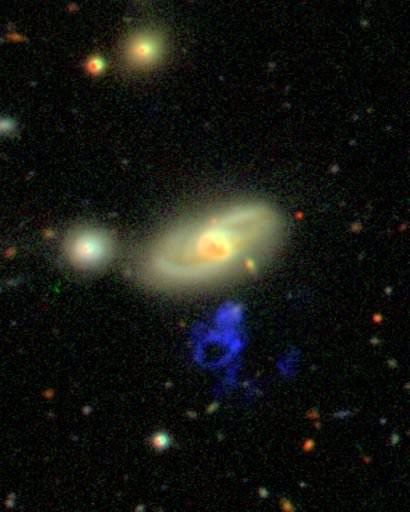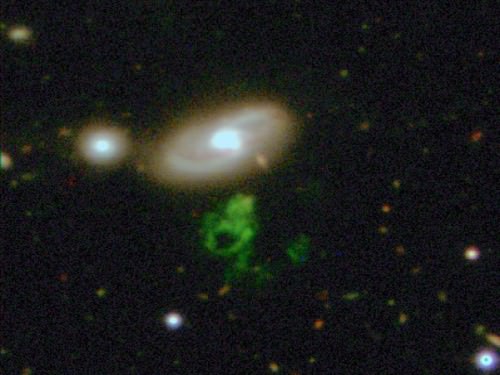[/caption]
The green “blob” is Hanny’s Voorwerp. Credit: Dan Herbert, Peter Smith, Matt Jarvis, Galaxy Zoo Team, Isaac Newton Telescope
A storybook astronomy mystery is now part of the most famous telescope in history. A team of astronomers secured time on the Hubble Space Telescope to observe Hanny’s Voorwerp, the unusual object found by Dutch teacher Hanny Van Arkel while she was scanning through images for the Galaxy Zoo project. Hubble will be trained on the Voorwerp during three separate observing sessions, the first of which occurred on April 4, 2010. “The WFC3 (Wide Field Camera 3) images were obtained (Sunday),” said Principal Investigator Bill Keel from the University of Alabama in an email to Universe Today “and I was able to pull the calibrated files over last night for a quick look. Combining pairs of offset images to reject cosmic rays optimally will take some further work, but we’re happy to start working with the data and see what emerges at each step.”
The Voorwerp (also known by the much less endearing name of SDSS J094103.80+344334.2) created a sensation among amateur, armchair and professional astronomers alike, almost immediately after Van Arkel saw the object in 2007 and posted a question on the Galaxy Zoo forum, asking “What is this?” All this took place just a month after the Galaxy Zoo project opened up their online citizen science shop, and the rest is history. But in case you haven’t heard the story yet, a quick rundown is that ‘voorwerp’ means ‘object’ in Dutch – and as of yet, no one has determined exactly what Hanny’s Voorwerp is.
The working hypothesis, according to the Galaxy Zoo team, is that Hanny’s Voorwerp might be a “light echo” of an event that occurred millions of years ago. The object itself consists of dust and gas which perhaps was illuminated by a quasar outburst within the nearby galaxy IC 2497 (see the images). The outburst has faded within the last 100,000 years but the light reached the dust and gas in time for our telescopes to see the effect.

The Galaxy Zoo images come from observations done by the Sloan Digital Sky Survey. In evidence of the interest in this object, since 2007 Hanny’s Voorwerp has also been imaged by the Swift gamma-ray satellite, the Suzaku X-ray telescope, the Westerbork Synthesis Radio Telescope (WSRT), the Issac Newton Telescope and the William Herschel Telescope, to name a few.
But now, the most famous telescope of all – with its new and updated instruments – will take a gander to see if the mysteries of the Voorwerp can be solved.
The team – which includes Keel, and fellow Galaxy “Zookeepers” Chris Lintott, Kevin Schawinski, Vardha Nicola Bennert, Daniel Thomas, and Hanny Van Arkel herself – submitted a proposal to the Space Telescope Science Institute back in 2008 and were among the proud and few from close to 1000 proposals submitted to be granted observing time on Hubble.
During the three observing sessions, three different Hubble instruments will be used.
“The observations use three instruments and would naturally be broken into three target visits,” said Keel, “some constrained to be at different times because of the required orientations on the sky –for example, to have both Hanny’s Voorwerp and IC 2497 in the narrow field of view of ACS (Advanced Camera for Surveys) with the monochromatic ramp filters.”
“The next observations will probably be the most visually striking,” Keel continued. “Two orbits’ worth of ACS images in narrow bands including [O III] an H-alpha emission, and are scheduled for April 12. The final visit in the program has 2 orbits of STIS (Space Telescope Imaging Spectrograph) spectroscopy around the nucleus of IC2497, and should be coming up by mid-June.”
The April 4 observations included three orbits of data from the WFC3.
So, even though the first images have now been seen, the team won’t be able to share their findings until all the observations have occurred and the data has been analyzed.

“I indeed can’t say much more than that we got the first data in our mailboxes,” Van Arkel said in an email to Universe Today. “The team is still working on it and until they’ve worked it out, I won’t even understand enough of it myself to explain anything on the matter. It is exciting however that the investigations have started and it’s nice to see how many curious people are sending me messages about it and ‘retweeting’ my quotes on Twitter. After almost two years, I’m very much looking forward to the outcome of all of this!”
Van Arkel isn’t the only one excited.
“Through a combination of geometry and weather,” Keel shared,”I saw HST sail by to our south less than two orbits after it finished this first data set. So I waved in what was probably a most unprofessional manner.”
And the rest of us will be waiting – and waving – until Hubble can tell us more about Hanny’s Voorwerp.
For more information:
Galaxy Zoo
For other citizen science projects, visit the Zooniverse


Did every other guy on Universe today just wonder where astronomer girls like that were back when were single? I sure did.
Girls and astronomy? LOL
There are too few of them!
I had an opportunity to interview the lovely Hanny for the 365 Days of Astronomy Podcast. If you have not heard it yet please have a listen:
http://365daysofastronomy.org/2009/05/21/may-21st-hannys-voorwerp-and-the-galaxy-zoo/
Really guys? Are we all thirteen-year-olds here? Do we really have to have the sexist comments?
Personally, I think this unusual object is galactic, and might be just a casual remnant like some unusual planetary nebula, nova ejecta, etc. It looks like an annular ring, and if you draw a line perpendicular to the axis, we find a hazy-yellow elongated ‘stellar’ object over the galaxy, with another opposing dim reddish spot on the opposite side of the annular ring.
I do look forward to any spectra gained, though [O III] an H-alpha emission is dead give away to a planetary nebulae or an old bipolar planetary nebulae (if the other two blobs are truly associated.) How an object could shine in [O-III] and be galaxy-sized is well beyond me!
As for releasing the results – well I don’t blame the researchers at all. They do the hard yards to get the telescope time show they deserve the time to publish the findings. Nonetheless, others will read their solutions and challenge some of their conclusions, then they find other alternatives and other ways for new observations. Such is the way real science works.
is this object either anagalactic or extragalactic is perhaps the biggest question!
http://en.wikipedia.org/wiki/Hanny's_Voorwerp explains that this object is at the same distance as its neighbouring galaxy, about 700 million ly away.
HSB Crumb,
A couple of papers have been published in the last year detailing some ground-based observations of this object( http://arxiv.org/abs/0906.5304 ). Spectra from the William Herschel Telescope and Lick indeed confirm strong emission lines of OIII, OII, H-alpha, H-beta, NeV and HeII from the Voorwerp (and at the same distance as IC 2497!). These observations whet the appetite for the Hubble data to come. A most peculiar object.
@MarkW: I see where you are coming from, but mentioning that you think someone is pretty isn’t sexist. Bemoaning the fact that there aren’t more brainy, pretty girls in astronomy is in fact just the opposite of sexist.
@Kevin: There was a rather vulgar comment (that has since been removed) that prompted mine. I’ll admit my comment does look a bit like an overreaction now.
However, if Hanny’s Voorwerp had been Hansje’s Voorwerp, how many comments would have been about “his” physical attractiveness?
I just don’t like it that the first point of reference about a woman in science is her looks. And face it, you’re still there — why is it important to have pretty women rather than just women in general?
I don’t think it does us men any favours either; there’s already the perception of sciencey guys being completely socially inadequate around women. I guess it’s not that big a deal, it’s just something I pick up on a lot on science blogs and websites.
I agree with Kevin, there is nothing sexists in the comments. On the contrary, there is praise. And we really would like more women in science out there.
Also I would love more women in my profession of IT/ICT and software development. Too many workers are man in these area’s.
“why is it important to have pretty women rather than just women in general?”
MarkW, are you saying that not all women are pretty looking?
“I indeed can’t say much more than that we got the first data in our mailboxes,… After almost two years, I’m very much looking forward to the outcome of all of this!”
What more needs to be said.
Male or female, it makes no difference in this story.
Who wouldn’t be excited?
@MarkW: Makes sense, if I missed a deleted comment. Yours was directed in general though: “Really guys? Are we all thirteen-year-olds here?”.
It’s all good, no problems.
It was my comment. I’m sorry everyone. I was drunk when I posted.
Even with beer goggles off she’s still the hottest astronomer I’ve ever seen. Nothing lude about saying that.
Bonan –
It is just a harmless observation.
Finding a female scientist/astronomer attractive is not sexist by any stretch – it’s just a statement that there are way too many ugly ass men in the profession. PERIOD!
There are several hot women on the Space shows that are shown on Nat Geo – History Channel and the Science channel. It is MUCH more pleasant to hear them discuss a subject.
Amy Mainz is REALLY HOT!